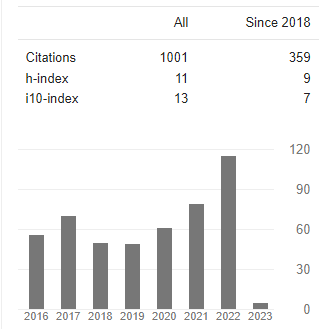Runners High: Intense boost of Happiness
Abstract
Runner’s high is an intense boost of happiness and pleasure following a prolonged
period of exercise. During this experience, some people may also feel a reduction in levels of
pain and stress. Depending on the person, the experience of runner’s high may occur 30
minutes into exercise or not until an hour after starting. This time frame is likely dependent on
how regularly a person runs and their level of endurance. Although people typically associate
the feeling with running, many other forms of aerobic exercise, such as cycling, swimming,
and rowing, may offer a similar sensation. The runner’s high is a curious aspect to study. By
definition, it is possibly not going to give any Knowledgeable results in research centres
circumstances (like running on a treadmill), where one had some control over various factors
like climate, landscape, speed, etc.
Downloads
References
Berger, B. G., & Tobar, D. A. (2007). Physical activity and quality of life: Key
considerations. In G. Tenenbaum & R. C. Eklund (Eds.), Handbook of
sport psychology (3rd ed., pp. 598–620). Hoboken, NJ: Wiley.
Jackson, S., & Csikszentmihalyi, M. (1999). Flow in sports: The keys to optimal
experiences and performances. Champaign, IL: Human Kinetics.
course and displacement of center of gravity, American Journal of Sports Science, Vol.2 Issue.5 pp: 122-126 (2014). Retrieved from https://www.sciencepublishinggroup.com/journal/paperinfo.aspx?journalid=155&doi=10.11648/j.ajss.20140205.13
Mandeep Singh (2010). Evaluation And Improvement Of Sports Techniques Through Biomechanical Updated Analyzing Technology, University News, Journal of Higher Education Association of Indian Universities, Association of Indian Universities, Vol:48:Issue.05;2010 Pp45-57, 2010
Mandeep Singh Nathial, A Study of Adjustment and Emotional Intelligence of University Coaches in India, American Journal of Applied Psychology. Volume 3, Issue 6, November 2014 , pp. 122-126. doi: 10.11648/j.ajap.20140306.11
Nathial, Mandeep Singh. A COMPARATIVE AND ANALYTICAL STUDY OF SELF-ESTEEM AND JOB SATISFACTION IN ATHLETES AND NON ATHLETES. Journal of Advances in Social Science and Humanities, 2(10).https://doi.org/10.15520/jassh210123
Sachs, M. L. (1984). The runner’s high. In M. L. Sachs & G. W. Buffone
(Eds.), Running as therapy: An integrated approach (pp. 273–287).
Lincoln:University of Nebraska Press.
SINGH SIDHU, A., & SINGH, M. (2022). KINEMATICAL ANALYSIS OF HURDLE CLEARANCE TECHNIQUE IN 110M HURDLE RACE. International Journal of Behavioral Social and Movement Sciences, 4(2), 28–35. Retrieved from https://ijobsms.org/index.php/ijobsms/article/view/267
Singh, A., & Singh , D. M. (2013). PROMOTION OF RESEARCH CULTURE –ENHANCING QUALITY IN HIGHER EDUCATION. International Journal of Behavioral Social and Movement Sciences, 2(2), 202–208. Retrieved from https://ijobsms.org/index.php/ijobsms/article/view/152
SINGH, M., & SINGH SIDHU, A. (2016). A COMPARATIVE STUDY OF BODY COMPOSITION AND RELATIVE HEALTH STATUS AMONG RESIDENT AND NON-RESIDENT STUDENTS IN DIFFERENT SCHOOLS OF J&K. International Journal of Behavioral Social and Movement Sciences, 5(3), 08–13. Retrieved from https://ijobsms.org/index.php/ijobsms/article/view/320
Singh Nathial, D. M. (2012). ANALYZING THE CREDIT BASED SYSTEM IN PHYSICAL EDUCATION. International Journal of Behavioral Social and Movement Sciences, 1(3), 172–176. Retrieved from https://ijobsms.org/index.php/ijobsms/article/view/37
Abdalkareem Jasim S, Singh M, Al-Dhalimy AMB, Zwamel AH, Jawad IA, Shalaby NS. The Impact of Chronic Exercise on Cognitive Function: An Overview of Reviews. Iran J Psychiatry. 2024;19(4):463-472. https://ijps.tums.ac.ir/index.php/ijps/article/view/3895
Yasmin Basheer Ahmed, Saade Abdalkareem Jasim, Yasser Fakri Mustafa, Beneen Husseen, Thoraya Mahbas Diwan, Mandeep Singh, The effects of propolis supplementation on lipid profiles in adults with metabolic syndrome and related disorders: A systematic review and meta-analysis of randomized controlled trials, Human Nutrition & Metabolism,Volume 37,2024,200276,ISSN 26661497,https://doi.org/10.1016/j.hnm.2024.200276.(https://www.sciencedirect.com/science/article/pii/S266614972400038
Alameri AA, Ghanni MU, Ali A, Singh M, Al-Gazally ME, Almulla AF, Alexis Ramírez-Coronel A, Mustafa YF, Gupta R, Obaid RF, Gabr GA, Farhood B. The Effects of Curcumin on Astrocytes in Common Neurodegenerative Conditions. Mini Rev Med Chem. 2023;23(22):2117-2129. doi: 10.2174/1389557523666230502143131. PMID: 37132107. https://pubmed.ncbi.nlm.nih.gov/37132107/
Singh, M., Kadhim, M.M., Turki Jalil, A. et al. A systematic review of the protective effects of silymarin/silibinin against doxorubicin-induced cardiotoxicity. Cancer Cell Int 23, 88 (2023). https://doi.org/10.1186/s12935-023-02936-4 https://cancerci.biomedcentral.com/articles/10.1186/s12935-023-02936-4
Mandeep Singh Nathial, Analysis of set shot in basketball in relation with time to perform the course and displacement of center of gravity, American Journal of Sports Science, Vol.2 Issue.5 pp: 122-126 (2014). Retrieved from https://www.sciencepublishinggroup.com/journal/paperinfo.aspx?journalid=155&doi=10.11648/j.ajss.20140205.13
Singh, M., Kour, R., & Kour, A.,. A collaborative diversified investigation of respective responses of sports person coaches and organizations on criminalization of doping.International Journal of Health Sciences,6(S3), 11295–11310. https://doi.org/10.53730/ijhs.v6nS3.8641
Singh, A., & Singh , D. M. (2013). PROMOTION OF RESEARCH CULTURE –ENHANCING QUALITY IN HIGHER EDUCATION. International Journal of Behavioral Social and Movement Sciences, 2(2), 202–208. Retrieved from https://ijobsms.org/index.php/ijobsms/article/view/152
SINGH, M., & SINGH SIDHU, A. (2016). A COMPARATIVE STUDY OF BODY COMPOSITION AND RELATIVE HEALTH STATUS AMONG RESIDENT AND NON-RESIDENT STUDENTS IN DIFFERENT SCHOOLS OF J&K. International Journal of Behavioral Social and Movement Sciences, 5(3), 08–13. Retrieved from https://ijobsms.org/index.php/ijobsms/article/view/320
Singh Nathial, D. M. (2012). ANALYZING THE CREDIT BASED SYSTEM IN PHYSICAL EDUCATION. International Journal of Behavioral Social and Movement Sciences, 1(3), 172–176. Retrieved from https://ijobsms.org/index.php/ijobsms/article/view/37
SHARMA, N. P., & SINGH, M. (2014). SENIOR AGE GROUP RELATIVE EXERCISES AND IMPACT ON THEIR LIFESTYLE. International Journal of Behavioral Social and Movement Sciences, 3(04), 78–82. Retrieved from https://ijobsms.org/index.php/ijobsms/article/view/246
CHAND PURI, P., MISHRA, P., JHAJHARIA, B., & SINGH, M. (2014). COORDINATIVE ABILITIES OF VOLLEYBALL IN DIFFERENT AGE GROUPS: A COMPARATIVE STUDY. International Journal of Behavioral Social and Movement Sciences, 3(3), 56–68. Retrieved from https://ijobsms.org/index.php/ijobsms/article/view/228

Copyright (c) 2024 Mamta Sharma, Pakhi saini

This work is licensed under a Creative Commons Attribution 4.0 International License.














